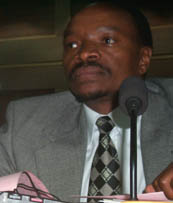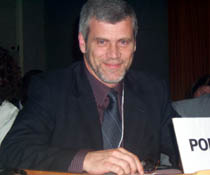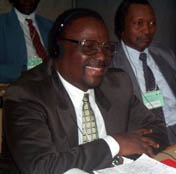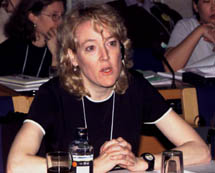 |
 TURKMENISTAN urged caution in developing joint work with the
CCD, noting its emphasis on Africa.
TURKMENISTAN urged caution in developing joint work with the
CCD, noting its emphasis on Africa.
|
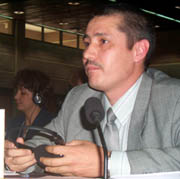 |
 Namibia, on behalf of the AFRICAN GROUP, proposed minimizing
costly, post-hoc disaster relief in Africa by integrating the
diversification of livelyhoods; indigenous drought-coping stratagies
in drylands, riverbasin management and biodiversity-friendly initiatives
at regional and national levels
Namibia, on behalf of the AFRICAN GROUP, proposed minimizing
costly, post-hoc disaster relief in Africa by integrating the
diversification of livelyhoods; indigenous drought-coping stratagies
in drylands, riverbasin management and biodiversity-friendly initiatives
at regional and national levels
|
 NIGERIA, on behalf of the G-77/CHINA, stressed the issue's importance
for developing countries, including the need for a financial mechanism,
and highlighted the need for assessments of biodiversity status
and trends.
NIGERIA, on behalf of the G-77/CHINA, stressed the issue's importance
for developing countries, including the need for a financial mechanism,
and highlighted the need for assessments of biodiversity status
and trends.
|
|
|
 TANZANIA called for a review of the work programme's implementation
at SBSTTA-7 and supported creation of an ad hoc technical expert group
at COP-6.
TANZANIA called for a review of the work programme's implementation
at SBSTTA-7 and supported creation of an ad hoc technical expert group
at COP-6. |
|
|
Working
Group Two: ACCESS TO GENETIC RESOURCE
|
 The FAO drew attention to its report on the International Undertaking
on Plant Genetic Resources (UNEP/CBD/COP/5/Inf.12)
The FAO drew attention to its report on the International Undertaking
on Plant Genetic Resources (UNEP/CBD/COP/5/Inf.12)
|
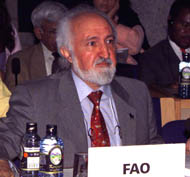 |
|
|
 CGIAR stated that countries developing ABS legislation should
include flexible measures to allow for a multilateral system for access
to genetic resources for food and agriculture.
CGIAR stated that countries developing ABS legislation should
include flexible measures to allow for a multilateral system for access
to genetic resources for food and agriculture. |
|
|
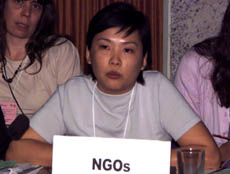 |
|
|
 A representative of the MAORI PEOPLE stressed linkages between
the Expert Panel and the Working Group on Article 8(j)
A representative of the MAORI PEOPLE stressed linkages between
the Expert Panel and the Working Group on Article 8(j) |
|
|
Side event: Workshop on
Strategic Planning for Access to Genetic Resources & Benefit-Sharing
|
|
 Karry
ten Kate [ktenkate@rbgkew.org.uk]
, Conventions and Policy Section, Royal Botanical Gardens Kew, facilitated
a workshop on case studies and ways to incorporate access to genetic
resources and benefit sharing provisions within National Biodiversity
and Strategic Action Plans (NBSAP). She said remaining challenges
include addressing the complexity of NBSAP processes, how to involve
and who to involve in participatory mechanisms and the integration
of elements pertinent to potential multilateral and bilateral contractual
arrangements for facilitating access to plant genetic resources
for food, agriculture or pharmaceutical purposes. Karry
ten Kate [ktenkate@rbgkew.org.uk]
, Conventions and Policy Section, Royal Botanical Gardens Kew, facilitated
a workshop on case studies and ways to incorporate access to genetic
resources and benefit sharing provisions within National Biodiversity
and Strategic Action Plans (NBSAP). She said remaining challenges
include addressing the complexity of NBSAP processes, how to involve
and who to involve in participatory mechanisms and the integration
of elements pertinent to potential multilateral and bilateral contractual
arrangements for facilitating access to plant genetic resources
for food, agriculture or pharmaceutical purposes.
Krystyna
Swiderska [kswiderska@iied.org,
on the right of the middle photo], UK International Institute
for Environment and Development, presented preliminary results of
an analysis of participation planning processes taken within access
to genetic resource, traditional knowledge and biodiversity strategies
and policy drafting in Peru, the Philippines, India and South
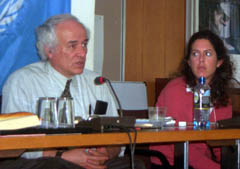 Africa.
She emphasized that levels of acceptance and implementation of such
strategies, including NBSAPs, are directly related to the level
of participation a broad range of stakeholders in their design,
a key element increasing awareness and enabling a greater sense
of ownership and legitimacy in necessary consensus building during
policy drafting and implementation processes. Africa.
She emphasized that levels of acceptance and implementation of such
strategies, including NBSAPs, are directly related to the level
of participation a broad range of stakeholders in their design,
a key element increasing awareness and enabling a greater sense
of ownership and legitimacy in necessary consensus building during
policy drafting and implementation processes.
Mario
Baudoin, Director Generale de Biodiversidad [left in the middle
photo], Ministeria de Desarollo Sustenible, Bolivia, spoke on
Bolivia's recent access legislation and NBSAP experience. Their
strategic goal have been to develop the economic potential of biodiversity
for the benefit of the population and the natural patrimony of Bolivia.
He highlighted the need for local, sub-national questionnaires with
questionnaires and interviews before having a national workshop
for eventual synthesis of technical and civil society feedback with
original working documents of access and biodiversity legislation.
Bansuri
Taneja [ambart@vsnl.com,
bottom photo, right], Kalpavrish India, described her NGO's
facilitation of the participatory process for the government of
India in a manner aimed at cross-sectoral integration of the ethical,
cultural, scientific and economic dimensions of biodiversity, access
and benefit-sharing. She said India's NBSAP amalgamates local sub-state,
national, inter-state eco-regional and separate detailed thematic
strategy and action plans, including on domesticated biodiversity,
health, livelihoods, education, access to genetic resources and
intellectual property rights. Its participatory process has solicited
inputs. She emphasized that any methodology for integrating access
and benefit-sharing into NBSAPs must: consider cross-sectoral links;
include implementation agencies and action-oriented proposals; solicit
inputs via letters, public and specialized workshops, press releases,
electronic and folk media; assess existing legislation in order
to reform them accordingly; respect and protect indigenous knowledge,
food security, gender and equity dimensions.
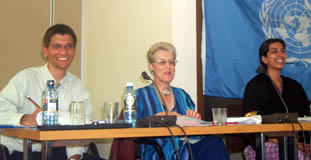 Maureen
M. Wolfson [mmw@nbipre.nbi.ac.za,
bottom photo, center], South African National Botanical Institute,
described South Africa's a 2 year, bottom-up NBSAP consultative
process. Its culmination was a Biodiversity White Paper amalgamating
policy recommendations put together from several local language
commentaries and provincial workshops involving over 3000 organizations.
This NBSAP process halted, however, due to changing state authorities
and lack of political will for implementation. This situation is
now changing to incorporate revised legislation and implementation
priorities for biodiversity-related activities, including benefit-sharing,
protected area management and sustainable use of wildlife. Nevertheless,
participation of local and indigenous peoples not formally organized
remains a challenge. Maureen
M. Wolfson [mmw@nbipre.nbi.ac.za,
bottom photo, center], South African National Botanical Institute,
described South Africa's a 2 year, bottom-up NBSAP consultative
process. Its culmination was a Biodiversity White Paper amalgamating
policy recommendations put together from several local language
commentaries and provincial workshops involving over 3000 organizations.
This NBSAP process halted, however, due to changing state authorities
and lack of political will for implementation. This situation is
now changing to incorporate revised legislation and implementation
priorities for biodiversity-related activities, including benefit-sharing,
protected area management and sustainable use of wildlife. Nevertheless,
participation of local and indigenous peoples not formally organized
remains a challenge.
Adrian
Wells [A.Wells@rbgkew.org,
bottom photo, left], Conventions and Policy Section, Royal Botanical
Gardens Kew, said the scope of access and benefit-sharing policies
within NBSAPs ought to address both national needs (e.g. poverty
alleviation, livelihood sustainability and capacity-building) and
those important to maintaining international partnerships with pharmaceuticals
and taxonomic institutions. He added that scientific training and
research coordination aimed at integrating taxonomy, biochemistry
and protected areas concerns for example are as critical as enterprise
development through incentives, accreditation and certification
infrastructures.
Subsequent
discussion centered on: counterbalancing participation with strategic
leadership; differential participation realities and if to distinguish
between different stakeholders and their respective roles, paying
particular attention to those with less political economic power
and voice; recognition of owners and users, national and international
actors and regulators of genetic resources; how inclusion of international
participants can help not restrict access to genetic resources;
the need to include implementation agencies and persons in drafting
and planning process for access and benefit-sharing legislation;
and extending benefit-sharing into NBSAPs and the revision International
Undertaking for Plant Genetic Resources for Plant Genetic Resources
through both multilateral and bilateral arrangements for regulating
access to and distribution of genetic resource material and knowledge
from designated collections, breeding programs and protected areas.
For
more information: [http://www.rbgkew.org.uk/]
and [http://www.iied.org.uk/]
|
|
|
Side event: Biodiversity
Incentives
|
|
The
Organization for Economic Cooperation and Development (OECD)
and IUCN-The World Conservation Union
hosted a workshop on incentives for biodiversity conservation, sustainable
use and benefit-sharing. Discussion centered on: how to implement
incentives and policy activities at local and national levels; incentives
and trade-related issues arising from the CBD, CITES and the WTO;
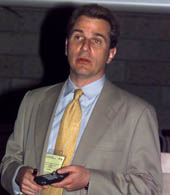 the
impacts of trade liberalization on biodiversity; and whether intellectual
property rights could be used as effective incentives the
impacts of trade liberalization on biodiversity; and whether intellectual
property rights could be used as effective incentives
Dan
Biller, OECD, reviewed OECD initiatives regarding biodiversity in
areas such as agriculture, food safety and biotechnology. He described
the OECD Working Group on Economic Aspects of Biodiversity, which
has focused on markets for biodioversity, incentives and valuation,
access to genetic resources and benefit-sharing. Incentives considered
have included fees, taxes, trading rights, market creation and the
reduction of adverse incentives, given information provision, capacity
and institution building and stakeholder involvement considerations.
Frank
Vorhies, IUCN,
 discussed
his institution's new Quadriennual Program on incentives and economics
which concentrates on: harmonizing global biodiversity-related policies
with national policy implementations through national biodiversity
strategies and action plans; public conservation finance including
guidelines for accessing GEF funds; private conservation finance
such as the Kijami initiative for business and biodiversity in Africa).
He stressed the need for a collaborative program on biodiversity
incentives that embraces the ecosystem approach, focuses on assessments
of biodiversity incentives and engages other international players
such as UNCTAD, the World Bank, the GEF, World Wildlife Fund, the
Wetlands Convention and WWF. discussed
his institution's new Quadriennual Program on incentives and economics
which concentrates on: harmonizing global biodiversity-related policies
with national policy implementations through national biodiversity
strategies and action plans; public conservation finance including
guidelines for accessing GEF funds; private conservation finance
such as the Kijami initiative for business and biodiversity in Africa).
He stressed the need for a collaborative program on biodiversity
incentives that embraces the ecosystem approach, focuses on assessments
of biodiversity incentives and engages other international players
such as UNCTAD, the World Bank, the GEF, World Wildlife Fund, the
Wetlands Convention and WWF.
More
information:
OECD Biosafety - BioTrack [http://www.oecd.org/ehs/service.htm]
IUCN Economics Program [http://economics.iucn.org/]
|
|
|
Side event: The River Basin
Initiative
|
|
Salvatore
Arico, CBD Secretariat with Delmar Blasco, Ramsar Wetlands Convention
Executive Secretary [below right], and Faizal Parish, Global Environment
Network [below left], introduced the River Basin Initiative, a joint
project of the CBD and Ramsar Convention on integrating wetlands,
biodiversity and river basin management. Parish identified reasons
for the initiative, including river and water pollution, loss of
biodiversity and local community livelihoods and increased CO2 emissions.
He also detailed the development of the initiative. A handbook on
integrating wetland conservation and wise use into river basin management
is available directly from the Ramsar Secretariat, or online at
[http://www.ramsar.org/key_guide_basin_e.htm]
|

|

|
|
|
Side event: Gender and Biodiversity
|
|
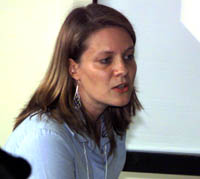 A
workshop entitled "Pushing through the Glass Ceiling on Gender
and Biodiversity" was hosted by the German Agency for Technical
Cooperation's (GTZ) and attended by representatives from Africa,
Asia, Latin and North America, Europe and Australia. Presentations
were given by coordinators of the GTZ Project on the Implementation
of the CBD, Andreas Gettkant [andreas.gettkant@gtz.de,
below left] and Christine Schäfer [Christine.Schaefer@gtz.de,
on the left]; Lucy Mulenki of the African A
workshop entitled "Pushing through the Glass Ceiling on Gender
and Biodiversity" was hosted by the German Agency for Technical
Cooperation's (GTZ) and attended by representatives from Africa,
Asia, Latin and North America, Europe and Australia. Presentations
were given by coordinators of the GTZ Project on the Implementation
of the CBD, Andreas Gettkant [andreas.gettkant@gtz.de,
below left] and Christine Schäfer [Christine.Schaefer@gtz.de,
on the left]; Lucy Mulenki of the African
 Indigenous
Women's Organization and a representative of Peru's National Environmental
Council. Panelists highlighted the differential opportunities and
rights to biodiversity between the men and women as well as their
differing knowledge about biological diversity, such that women
make use of different biodiversity than men or make use of the same
resources in very different ways. While gender and agriculture has
been well studied, issues pertinent to biodiversity and gender remain
understudied. Participants focused on how to integrate gender into
the CBD's work programmes, how to better involve indigenous women's
organizations and gender differentiation needs in Article 8(j)'s
implementation. For more information contact the GTZ Pilot Programme
on Gender coordinator: Indigenous
Women's Organization and a representative of Peru's National Environmental
Council. Panelists highlighted the differential opportunities and
rights to biodiversity between the men and women as well as their
differing knowledge about biological diversity, such that women
make use of different biodiversity than men or make use of the same
resources in very different ways. While gender and agriculture has
been well studied, issues pertinent to biodiversity and gender remain
understudied. Participants focused on how to integrate gender into
the CBD's work programmes, how to better involve indigenous women's
organizations and gender differentiation needs in Article 8(j)'s
implementation. For more information contact the GTZ Pilot Programme
on Gender coordinator:
Martha
Guiterrez [Martha.guitierrex@gtz.de]
|
|
|
Side event: The CBD and
Procedural Rights in Africa
|
|
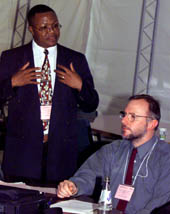 This
side event was co-organized by the African Center for Technology
Studies (ACTS), the World Resources
Institute (WRI) and Lawyers' Environment Action Team Tanzania
(LEAT) and chaired by Prof. John Y. Okedi, National Environment
Authority of Uganda. This
side event was co-organized by the African Center for Technology
Studies (ACTS), the World Resources
Institute (WRI) and Lawyers' Environment Action Team Tanzania
(LEAT) and chaired by Prof. John Y. Okedi, National Environment
Authority of Uganda.
Peter
Veit [peterv@wri.org, seated],
WRI Regional Director for Africa, said that environmental procedural
rights include access to environmental information, justice and
participation in decision-making processes as per Principle 10 of
the Rio Declaration, the 1998 Aarhus Convention and all UNCED Conventions
and Protocols. He noted that the right to environment is protected
by most African Constitutions, while the right to life, which can
be interpreted to include environmental concerns, is protected by
all of them. Procedural rights are also included in the fundamental
freedoms. He highlighted their importance for citizens' empowerment
both in national and regional levels and emphasized the challenge
faced by African countries to create a regional instrument to protect
environmental procedural rights and to revise existing legislation.
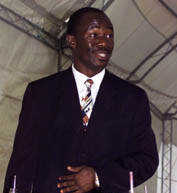 Tundu
A. Lissu [mat@twiga.com],
LEAT Staff Attorney, highlighted the state of law regarding environmental
procedural rights in Tanzania, while Godber W. Tumushabe [godben@infocom.co.ug,
standing in the photo above], Executive Director of Advocates
Coalition for Development and Environment in Uganda, described those
in Tanzania, especially regarding environmental impact assessment
processes. Tundu
A. Lissu [mat@twiga.com],
LEAT Staff Attorney, highlighted the state of law regarding environmental
procedural rights in Tanzania, while Godber W. Tumushabe [godben@infocom.co.ug,
standing in the photo above], Executive Director of Advocates
Coalition for Development and Environment in Uganda, described those
in Tanzania, especially regarding environmental impact assessment
processes.
Benson
Ochiang [b.ochieng@cgiar.org,
photo on the left], ACTS Kenya, noted that individual citizens
and indigenous peoples in Africa are limited in what they can do
or demand regarding environmental rights and biodiversity, since
these are considered to be state sovereignty matters.
Subsequent
discussion touched on links between procedural environmental rights
and environmental impact assessment processes, procedural rights
in CBD implementation and the necessity of regional and global instruments
to protect environmental rights.
|
IN
THE BREEZEWAYS
 As the Working Groups progressed on their agendas, many delegates
were anticipating the discussions on the forest work programme,
especially given the recent conclusion of the Intergovernmental
Forum on Forests. Some participants hoped that calls at SBSTTA-5
to make the work programme more action-oriented would spur progress
before COP-6. Others thought that re-opening the work programme
at this point would be thorny and provide few benefits. Several
delegates saw potential in focusing activities on the Proposals
for Action of the Intergovernmental Panel on Forests relevant to
the CBD.
As the Working Groups progressed on their agendas, many delegates
were anticipating the discussions on the forest work programme,
especially given the recent conclusion of the Intergovernmental
Forum on Forests. Some participants hoped that calls at SBSTTA-5
to make the work programme more action-oriented would spur progress
before COP-6. Others thought that re-opening the work programme
at this point would be thorny and provide few benefits. Several
delegates saw potential in focusing activities on the Proposals
for Action of the Intergovernmental Panel on Forests relevant to
the CBD.
Right:
at the UN compound at Gigiri, buildings are not separated
by closed corridors, instead they are linked by open breezeways.
|
|


